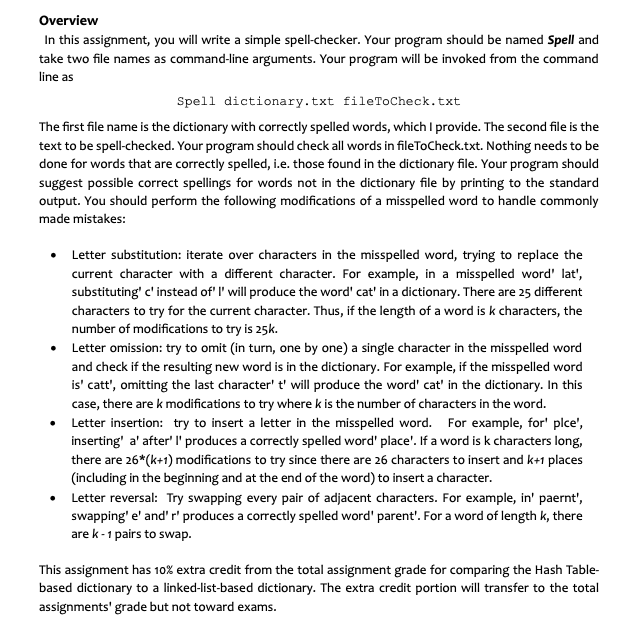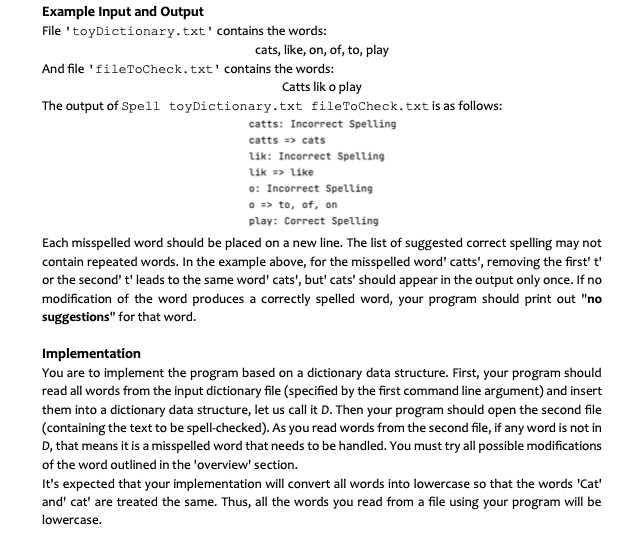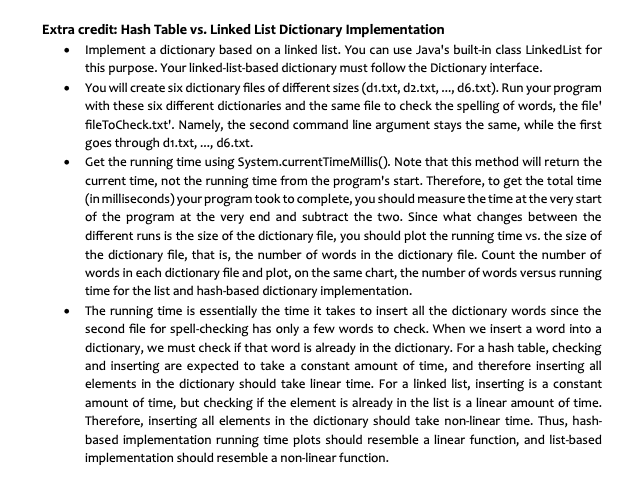Answered step by step
Verified Expert Solution
Question
1 Approved Answer
Please write it in Java fileToCheck.txt = Catts lik o play paernt toyDictionary.txt = cats like on of to play hello parent Overview In this
Please write it in Java


fileToCheck.txt =
Catts
lik
o
play
paernt
toyDictionary.txt =
cats
like
on
of
to
play
hello
parent
Overview In this assignment, you will write a simple spell-checker. Your program should be named Spell and take two file names as command-line arguments. Your program will be invoked from the command line as Spell dictionary.txt fileTocheck.txt The first file name is the dictionary with correctly spelled words, which I provide. The second file is the text to be spell-checked. Your program should check all words in fileToCheck.txt. Nothing needs to be done for words that are correctly spelled, i.e. those found in the dictionary file. Your program should suggest possible correct spellings for words not in the dictionary file by printing to the standard output. You should perform the following modifications of a misspelled word to handle commonly made mistakes: - Letter substitution: iterate over characters in the misspelled word, trying to replace the current character with a different character. For example, in a misspelled word' lat', substituting' c' instead of' l' will produce the word' cat' in a dictionary. There are 25 different characters to try for the current character. Thus, if the length of a word is k characters, the number of modifications to try is 25k. - Letter omission: try to omit (in turn, one by one) a single character in the misspelled word and check if the resulting new word is in the dictionary. For example, if the misspelled word is' catt', omitting the last character' t' will produce the word' cat' in the dictionary. In this case, there are k modifications to try where k is the number of characters in the word. - Letter insertion: try to insert a letter in the misspelled word. For example, for' plce', inserting' a' after' l' produces a correctly spelled word' place'. If a word is k characters long, there are 26(k+1) modifications to try since there are 26 characters to insert and k+1 places (including in the beginning and at the end of the word) to insert a character. - Letter reversal: Try swapping every pair of adjacent characters. For example, in' paernt', swapping' e' and' r ' produces a correctly spelled word' parent'. For a word of length k, there are k1 pairs to swap. This assignment has 10\% extra credit from the total assignment grade for comparing the Hash Tablebased dictionary to a linked-list-based dictionary. The extra credit portion will transfer to the total assignments' grade but not toward exams. Example Input and Output File 'toyDictionary.txt' contains the words: cats, like, on, of, to, play And file 'fileTocheck.txt' contains the words: Catts lik o play The output of Spell toyDictionary.txt fileToCheck.txt is as follows: catts: Incorrect Spelling catts cats Lik: Incorrect Spelting tik => Like o: Incorrect Spelling 0 to, of, on play: Correct Spelling Each misspelled word should be placed on a new line. The list of suggested correct spelling may not contain repeated words. In the example above, for the misspelled word' catts', removing the first' t' or the second' t' leads to the same word' cats', but' cats' should appear in the output only once. If no modification of the word produces a correctly spelled word, your program should print out "no suggestions" for that word. Implementation You are to implement the program based on a dictionary data structure. First, your program should read all words from the input dictionary file (specified by the first command line argument) and insert them into a dictionary data structure, let us call it D. Then your program should open the second file (containing the text to be spell-checked). As you read words from the second file, if any word is not in D, that means it is a misspelled word that needs to be handled. You must try all possible modifications of the word outlined in the 'overview' section. It's expected that your implementation will convert all words into lowercase so that the words 'Cat' and' cat' are treated the same. Thus, all the words you read from a file using your program will be Extra credit: Hash Table vs. Linked List Dictionary Implementation - Implement a dictionary based on a linked list. You can use Java's built-in class LinkedList for this purpose. Your linked-list-based dictionary must follow the Dictionary interface. - You will create six dictionary files of different sizes (d1.txt, d2.txt, ..., d6.txt). Run your program with these six different dictionaries and the same file to check the spelling of words, the file' fileToCheck.txt'. Namely, the second command line argument stays the same, while the first goes through d1.txt, ..., d6.txt. - Get the running time using System.currentTimeMillis(). Note that this method will return the current time, not the running time from the program's start. Therefore, to get the total time (in milliseconds) your program took to complete, you should measure the time at the very start of the program at the very end and subtract the two. Since what changes between the different runs is the size of the dictionary file, you should plot the running time vs. the size of the dictionary file, that is, the number of words in the dictionary file. Count the number of words in each dictionary file and plot, on the same chart, the number of words versus running time for the list and hash-based dictionary implementation. - The running time is essentially the time it takes to insert all the dictionary words since the second file for spell-checking has only a few words to check. When we insert a word into a dictionary, we must check if that word is already in the dictionary. For a hash table, checking and inserting are expected to take a constant amount of time, and therefore inserting all elements in the dictionary should take linear time. For a linked list, inserting is a constant amount of time, but checking if the element is already in the list is a linear amount of time. Therefore, inserting all elements in the dictionary should take non-linear time. Thus, hashbased implementation running time plots should resemble a linear function, and list-based implementation should resemble a non-linear functionStep by Step Solution
There are 3 Steps involved in it
Step: 1

Get Instant Access to Expert-Tailored Solutions
See step-by-step solutions with expert insights and AI powered tools for academic success
Step: 2

Step: 3

Ace Your Homework with AI
Get the answers you need in no time with our AI-driven, step-by-step assistance
Get Started


